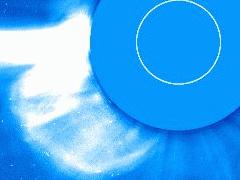 |
|
+ Home | ||

|
||||
| + Solar Cycle Prediction | + Magnetograph | + The Sun in Time | + The Hinode Mission | + The STEREO Mission |
Coronal Mass Ejections
Coronal mass ejections (or CMEs) are huge bubbles of gas threaded with magnetic field lines that are ejected from the Sun over the course of several hours. Although the Sun's corona has been observed during total eclipses of the Sun for thousands of years, the existence of coronal mass ejections was unrealized until the space age. The earliest evidence of these dynamical events came from observations made with a coronagraph on the 7th Orbiting Solar Observatory (OSO 7) from 1971 to 1973. A coronagraph produces an artificial eclipse of the Sun by placing an "occulting disk" over the image of the Sun. During a natural eclipse of the Sun the corona is only visible for a few minutes at most, too short a period of time to notice any changes in coronal features. With ground based coronagraphs only the innermost corona is visible above the brightness of the sky. From space the corona is visible out to large distances from the Sun and can be viewed continuously. The animated sequence of images at the top of this page were obtained with the High Altitude Observatory's coronagraph on the Solar Maximum Mission in April of 1980.
|
Coronal Mass Ejections disrupt the flow of the solar wind and produce disturbances that strike the Earth with sometimes catastrophic results. The Large Angle and Spectrometric Coronagraph (LASCO) on the Solar and Heliospheric Observatory (SOHO) has observed a large number of CMEs. The event of April 7th, 1997 is shown to the left (click on the image for the animation). It produced a "halo event" in which the entire Sun appeared to be surrounded by the CME. Halo events are produced by CMEs that are directed toward the Earth. As they loom larger and larger they appear to envelope the Sun itself. | ||
|
Coronal mass ejections are often associated with solar flares and prominence eruptions but they can also occur in the absence of either of these processes. The frequency of CMEs varies with the sunspot cycle. At solar minimum we observe about one CME a week. Near solar maximum we observe an average of 2 to 3 CMEs per day (3.4 MB MPEG movie from the SOHO/LASCO instrument showing a month of CMEs from 1998). | |||
